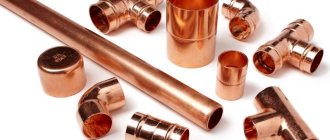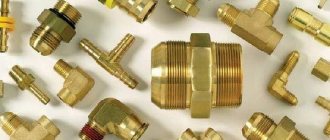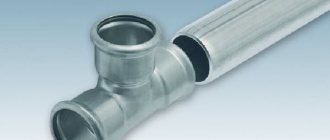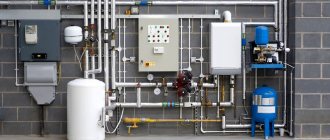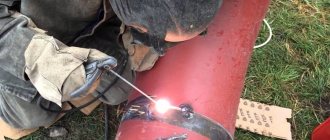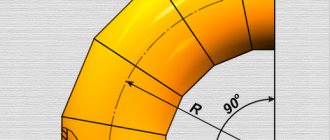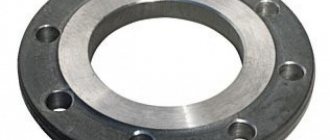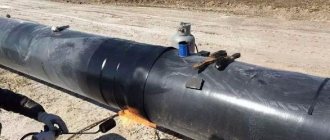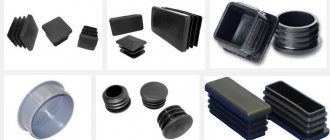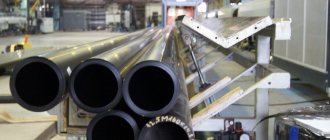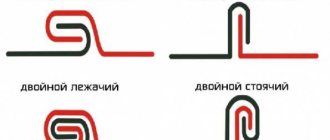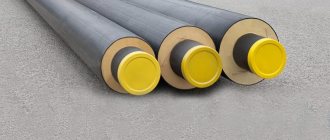A coupling is a connecting part with which a pipeline structure is mounted. Without connecting elements, the pipeline will be a straight section consisting of one pipe of a certain length. Modern pipeline structures are characterized by the presence of many parts that have different options for joining each other. They can also have different rotation angles, so during installation you cannot do without this type of part.
Using couplings of various types, pipelines from steel and other metal pipes are installed
What do couplings for metal pipes look like?
You can use different parts to connect metal pipes: there are many of them sold in the store. Thanks to couplings, the type of connection of pipeline elements can be any. At their core, the couplings we are talking about now are one of the types of fittings and perform the function of unification. These parts are attached to metal pipes using threads, which can be either inside or outside (there are options with threads on both sides).
A coupling is a hollow cylindrical part made of metal or other material (must be selected for a specific pipeline). Nowadays, polypropylene products for connecting plastic pipes are in great demand. Couplings can be either connecting or transitional. If this is a transitional part, then when installing it, for a better connection it is necessary to use materials such as FUM tape and flax thread.
Note! Transition couplings are installed when connecting pipes of different diameters.
The coupling can also be combined. It is necessary for connecting pipes made of different materials. Such couplings have a special thread, which allows you to easily connect, for example, metal pipes with plastic pipes, etc.
Read material on the topic: How to choose components for pipes
2.2.Installation of the coupling connection when using polypropylene pipes:
The simplest and most popular fitting can rightfully be considered a coupling for polypropylene. In fact, this is just a section of pipe with a thick wall with a slightly increased diameter, into which a propylene pipe is inserted with a certain force. In order to connect a propylene pipe using a coupling, low-temperature soldering is required.
• The internal chamfer is removed from the coupling, and the external chamfer from the pipe;
• A nozzle of the required size is installed on the soldering iron, and the temperature in the case of manual adjustment is set to 260-280 degrees;
• Pipes with aluminum reinforcement are cleaned: the inner aluminum layer is cleaned with a trimmer, and the outer layer with a shaver;
• The pipe must be inserted into the widened part of the nozzle, and a coupling must be put on the narrow part;
• To melt the surface of the pipe, a short pause is made, after which the pipe is inserted into the coupling, fixing it for 15-20 seconds.
When installing a pipe into a coupling, it is important to avoid turning, because the surface of the pipe may ripple, which can lead to a leak in the future.
Types of couplings for metal pipes
There are several types of couplings, each of which has its own special characteristics, and you can also find universal parts suitable for a wide variety of cases.
Here is the main classification of couplings:
- Threaded
- very actively used in the recent past, but now their scope is limited to steel pipes. They are quite difficult to install and, moreover, such couplings do not provide a very reliable connection.
- Compression
couplings for metal pipes are very similar to threaded parts. After installing them, the connection must be tightened with special nuts. To improve the tightness, rubber O-rings should be inserted into them.
- Press models
are often mistaken for crimp models. But there is a significant difference between them: installation of such couplings requires the use of special tools.
- Welded
couplings are used to connect polymer pipes.
- Electric welded couplings
are a type of welded coupling, but differ from them in the presence of a built-in heating coil. These parts are fixed to the pipes thanks to a special stop. After this, the heating element begins to work, heating the ends of the pipes to the melting point. After the temperature drops, the three elements (two pipes and a coupling) will turn into a single whole. This coupling can withstand a pressure of 10 bar for a gas pipeline and 16 bar for a water supply.
Couplings are usually used to connect metal pipes of different lengths and diameters. This is explained by the fact that these metal structures are produced in the form of small pieces.
The following types of couplings are distinguished:
- Angular
, with which you can change the direction of the pipeline. Such parts are quite common, since it is much more convenient to use them than to bend metal pipes.
- Direct or simple
. With the help of such couplings, you can very easily connect two metal pipes together. You cannot do without these parts when repairing a damaged section of a pipeline, as they allow you to quickly connect its elements to each other. Such couplings can also be used to join pipes made of different materials and having different diameters.
- Tee fittings
are needed to connect three pipes. When installing such a coupling, one of the pipes will be located at an angle of 90 degrees relative to the other two. These parts allow you to divert the pipeline to an angle of 45° or 90°. Using tees, you can connect pipes of any diameter.
- Cross fittings.
Here, perhaps, everything is clear by the name. They allow you to connect four pipes located in the same plane at an angle of 90° to each other. These couplings are easy to install and do not require the use of any special equipment. There are also crosses located in two planes, but they are found very rarely, as a rule, in manufacturing plants.
Read material on the topic: Types of pipe fittings: sizes and features
Sgony
Non-specialized information
The squeegee is also a connecting fitting, which is essentially a short tube. On one side, the part has a small thread for connecting to the fitting. At the other end there is a long thread on which the locknut and the entire coupling for connecting the pipes are placed.
It is necessary that the product has a sufficiently long thread, because if the parts do not fit in the area with the thread, it will be necessary to increase the distance between the connected ends of the pipe and the pipe, which will reduce the strength of the connection.
It must be stated that this connecting element is much more often used for water pipes. For this reason, it lacks good anti-corrosion protection. The most common types of surges are:
| Nickel plated | They are much more often used in residential premises in order to give the pipeline a more aesthetic appearance. It goes without saying that the price of such fittings is higher than simple steel ones. |
| Galvanized | Used in areas where the system is exposed to atmospheric phenomena. |
| Steel | Much more often they are used for pipelines that are laid in the ground. They are painted to protect against corrosion. |
In accordance with GOST 6357-73, the dimensions of pipe bends can be as follows:
| Product length, mm | Inner diameter, mm | Length of long threaded section, mm | Length of small threaded section, mm |
| 150 | 50 | 65 | 17 |
| 130 | 32 | 55 | 13 |
| 110 | 15 | 40 | 9 |
In addition, there are some intermediate sizes. Naturally, connecting parts are selected in accordance with the diameter of the pipeline.
Connection Features
The instructions for assembling the pipeline are as follows:
- First of all, a coupling is screwed onto the pipe.
- After this, the product is screwed with the small side into the connecting fitting (in some cases, the squeegee is connected directly). The connection must be strong, so you need to tighten the parts until they stop.
- A lock nut must be screwed onto the long end of the part..
- Then, from the side of the long threaded section, you need to screw the connecting fitting until it stops.
- Then you need to bring the end of the drive to the pipe and unscrew the coupling so that it slowly begins to move onto the pipe . The more correctly the axes of the parts coincide, the easier it is to make the connection.
- Then the fitting is locked with a lock nut; to do this, the lock nut must be tightened to the coupling, leaving a distance of a couple of centimeters . The space that appears between the parts must be filled with strands of flax, which are wound in the direction of rotation of the nut. Then the locknut is tightened until it stops, as a result of which the connection will be sealed and water will not be able to leak through it.
Couplings for metal pipes made of steel
For installation of metal steel pipes, threaded and compression couplings are used. Let's look at them in more detail next.
Threaded
Threaded couplings are made of black or stainless steel; they can be used to connect not only metal, but also other types of pipes. Externally, they look like a thick-walled cylinder with a regular one-sided internal thread.
Metal pipes are connected to each other by screwing them onto the coupling on both sides. This installation method is quite reliable, but to increase the sealing of the connection point, insulating materials are additionally used.
Note! Steel couplings are susceptible to corrosion, so brass parts are often installed instead. Pipes are not made from this material, but couplings are very common. They are corrosion resistant, easy to install, versatile and inexpensive.
If the couplings have a threaded connection made of a steel alloy, then great forces can be applied during their installation. However, it is really difficult to disassemble this type of thread, since due to the water condensation that forms, the pipeline elements “stick” to each other. Thus, for connecting metal steel pipes, it is recommended to choose threaded couplings made of brass or cast iron alloy, as their performance characteristics are better.
A connection with a squeegee is used when the pipeline elements cannot rotate around their axis.
Compression couplings
To ensure a greater degree of sealing when installing compression couplings, a rubber ring and a special union nut are used. These couplings are similar to those used to connect metal-plastic pipes, but have significant differences in their functionality.
Compression couplings can be threaded either internally or externally. Thanks to these parts, it is possible to connect, for example, metal pipes with plastic ones (the diameters may be different). Such couplings are also suitable for installing pipes with other fitting elements: all kinds of valves, taps, etc.
Compression fittings have the following characteristics:
- With their help, easily removable connections are obtained. If necessary, such a coupling can be easily removed and replaced.
- Metal steel pipes are connected to each other using compression elements without threads.
- When installing a compression fitting, it is necessary to clean the metal pipe from paint or rust.
- This is not a very reliable way to connect metal pipes and requires the use of additional fixing materials. These parts are very often used as a temporary element when repairing pipelines.
Note! For temporary connections, as a rule, universal couplings are used, which have a thread on one side and a special element for compression joining on the other.
Read material on the topic: Pipe plug
2.1.Installation of the coupling connection in the case of using metal-polymers:
When replacing an apartment's water supply with metal-plastic, first of all the valves are changed, and then the pipes. In this case, you will need an adapter.
• The most reliable and durable way to seal threads is to wind flax with natural drying oil and red lead.
• The adapter must be screwed onto the external thread. An adjustable or open-end wrench will help with this. Using a pipe wrench will leave visible scratches on the brass.
• You need to put a union nut and a split ring on the pipe. Then pull out the chamfer from the inside.
• A pipe is put on the fitting fitting; after which the union nut is tightened on the fitting body secured with an additional key. Thus, the split ring clamps the pipe onto the fitting, clamping the O-rings. It is very important not to move these rings.
The couplings must match the size of the metal-plastic pipe. The most popular sizes are 16, 20, 26 and 30 mm.
Couplings for metal pipes (cast iron)
To connect metal pipes made of cast iron, you can use one of the following two methods:
- Use a rubber seal during installation. This connection is very similar to joining plastic pipes. However, cast iron products are notoriously heavy, making installation difficult.
- Use couplings for metal pipes for embossing. This type of connection has been around for over a century. It is distinguished by the presence of two bells with opposite directions.
For the installation of sewers that remove wastewater and other substances, metal pipes made of gray cast iron, which are particularly durable, are used. If they are installed carefully and all requirements are met, the pipeline can last up to 50 years. Metal pipes made of cast iron can be either with or without sockets. The following types of couplings are suitable for connecting smooth elements:
- Sliding.
Their installation occurs in a hidden way. It is impossible to dismantle such couplings without disconnecting the main line.
- Repair roll-up.
These couplings include two main parts with a rubber or plastic gasket. In addition, these parts have special clamps and connectors for connection. They are often installed on those sections of metal pipes that have to be frequently repaired.
- Plastic.
These couplings for connecting metal pipes can be used more than once, which distinguishes them from others.
Peculiarities
The elements of engineering systems under consideration have various features that can be noted as advantages or disadvantages.
Connectors called “pipe couplings” have the following positive qualities:
- a light weight;
- quick and easy installation;
- low price;
- many varieties;
- Possibility of application in many areas;
- mechanical resistance.
Some types of couplings have certain disadvantages. For example, elements wear out quickly, become deformed, and not all of them are able to absorb vibrations.
To choose the appropriate options from those on the market, you need to take into account the scope of application of the products, as well as the material used to make the parts:
- Couplings can be rigid. These are the ones that are made of metal. The main scope of application of such couplings is various highways that have certain properties.
- Couplings can be spiral-shaped. Such products are usually aluminum. The main feature of the products is easy bending. The accessory has a special structure, thanks to which the specified function is ensured.
- Couplings can be polyurethane. Inserts made of this material are usually placed between two metal parts. Such a coupling is a shock-absorbing element that absorbs a significant portion of vibrations.
- Couplings are made of membrane types. The main feature of these products is that these elements are prefabricated. They are often used to connect parts located in different planes. The accessory is considered not only multifunctional, but also quite durable.
The pipeline network, which transports water under a certain pressure, consists of connections between individual sections of metal pipes. The water supply throughout its entire length, especially at the junctions of the pipes, must be dense, durable and impermeable to any temperature changes. The connection of steel pipes occurs by welding, threaded connections and flanges .
Flange connections are mainly used for large diameter pipes. In individual houses, apartments and gardens, pipes are connected using the threaded method, using connecting elements (fittings). The threaded connection allows, if necessary, to repair and replace individual pipeline segments without dismantling the complete system. It is accessible to anyone, while work related to welding requires appropriate qualifications and special equipment.
To join pipes without welding into a single system, steel fittings and connecting parts made of ductile cast iron are used. Cast iron connecting parts are used for water pipelines that pass hot steam or water no higher than 175 degrees - at a pressure in pipes of up to 1.6 MPa, the diameter of which is no more than 40 millimeters, and at a pressure of up to 1 MPa - in structures with a diameter of 50 mm or more up to 100 millimeters.
Steel fittings are used for products of all diameters with pressure up to 1.6 MPa. The cast iron connecting elements have thickened collars at the ends for maximum strength. Steel fittings do not have such collars.
Couplings for copper pipes
Couplings designed for installation of copper pipes are characterized by the highest reliability and durability. They belong to a higher class and, as a result, are more expensive. Couplings for copper pipes are of the following types:
- threaded;
- compression;
- capillary;
- press fittings.
It is necessary to take into account the fact that when installing copper pipes, the couplings must also be made of copper. This is a must. Compliance with this simple rule will ensure long-term and trouble-free operation of the pipeline. Couplings made from other materials can be used only if copper is not available when creating temporary pipelines.
The use of couplings when installing both metal and other types of pipes is the most common way to connect them. These parts are presented on the market in a wide range: they may have different fastening methods, shapes, and features of use. This way you can always choose the most suitable couplings for your pipes.
When purchasing, do not forget to take into account the material from which the pipes are made, as well as their diameter, wall thickness, temperature of the transported medium, length and shape of the future structure. Let's draw a small conclusion: if you take into account all the listed points, you will probably be able to purchase exactly those parts that will last a long time and will not create problems during operation.
Read material on the topic: Angles for pipes: overview of the range
Tips and tricks
- When working with cast iron pipes, you must remember that they are fragile. For embossing and pressing, use rubber hammers.
- If the installation of a socket joint is carried out outdoors in hot weather , then when the cement is in the gap, it is suggested to lay a damp cloth on it. So that the cement does not crack.
- When gas welding, the flammable gas acetylene is used. If desired, it can be replaced with propane, which is cheaper and safer.
- When constructing a water or gas supply pipe system, try to weld the rotary joints first, and then, when the entire structure is assembled, weld the fixed joint last.
- When tightening the bolts on the flanges, do not overtighten. It is possible to strip the thread, this also applies to threaded connections.
Advantages of the non-welding method
By connecting risers without welding, you can:
- get a detachable type docking. This option is acceptable if it is necessary to carry out repair work in a short time. At the same time, this procedure allows you to reuse the same fittings, replacing sealing materials, which significantly saves money;
- dock anywhere, regardless of the availability of electricity;
- improve the quality of the connection, since welding does not always produce an accurate seam, so that the risers do not move a millimeter or two relative to the axis and each other;
- do without an expensive craftsman, since a novice welder cannot carry out a high-quality operation of joining risers;
- do without expensive equipment and devices, since connection using fittings requires the presence of a gas wrench and simple skills.
Therefore, such installation work can be done by hand by anyone who has basic skills in handling keys and a great desire. All. Do not need anything else.
